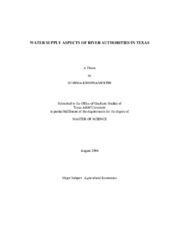| dc.description.abstract | Price has been noted to be an important ingredient in any evaluation of future
water demands, since it is a signal of cost administered by water wholesalers or retailers.
The purpose of this study is to contribute to a better understanding of rates and ratesetting
strategies adopted by the river authorities of Texas, and the relevance of
economic efficiency for wholesale purveyors of water. Methods employed to accomplish
the objectives include collecting sample water supply contracts, surveying rate
structures, and surveying authorities' rate-setting objectives.
In its current form the economic theory of pricing emphasizes price
establishment by retail water suppliers. There are certain distinctions between wholesale
suppliers and retail distributors of water that question the adequacy of the existing theory
in its universal application. This calls for a different theory of pricing for wholesale
suppliers of water. Therefore, an efficiency-seeking pricing theory for wholesale water
purveyors is explored here.
Out of the fifteen existing river authorities in Texas, ten have wholesale supply
operations. This study finds that out of the ten authorities that have wholesale operations,
some authorities charge the same uniform rate to all their customers, while some charge a different rate to each of their customers. The fact that some river authorities charge
different rates to different categories of customers for the same water is considered
economically inefficient. Another element that lends itself to economic inefficiency is
the usage of the block rates.
Through a questionnaire, the study finds that river authorities rank revenue
sufficiency highest among six objectives pertaining to rate-setting processes. Legality is
ranked second and economic efficiency is ranked third among these six goals. Though
there are ten river authorities that supply water on a wholesale basis, only eight valid
questionnaires responses could be used for the study.
All river authorities involved with the wholesale supply of water commit most of
their water supplies to municipal, agricultural, and industrial uses and customers through
water supply contracts that contain legal agreements, which are dealt with before the
river authority supplies the water to the customer. This study discusses the various
similarities and differences between contracts of the ten river authorities that are
involved in wholesale supply of water. Out of the ten river authorities, nine responded
with their wholesale water supply contracts. One river authority responded with two
contracts, therefore there were ten contracts that were studied. | en |


